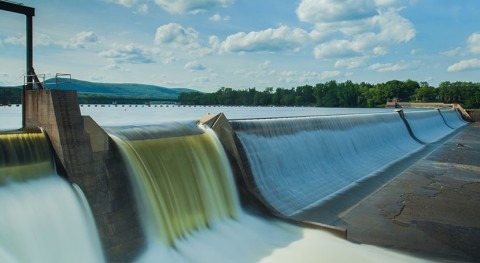The Environmental Protection Agency will require utilities to monitor the levels of toxic chemicals called per- and polyfluoroalkyl substances, or PFAS, in water systems, in what amounts to the first action the federal government has taken to set limits on PFAS pollution, according to a new regulation proposed by the agency on Tuesday.
Found in everything from clothing products and cooking appliances, to dental floss, firefighting foam and food packaging, PFAS, or "forever chemicals," have been linked to a range of health problems, including liver damage, certain forms of cancer, birth defects, immune system problems, asthma, among other health effects. The man-made chemicals are called "forever chemicals" because they don't easily degrade, and "have been found in the blood and breast milk of people and wildlife all round the world," experts note.
The new rule will require that certain forever chemicals be limited in water systems to 4 parts per trillion—the lowest level that can be detected in current testing. Prior to Tuesday's regulation, there were no regulations on the books whatsoever—only voluntary health advisories that delineated recommended limits.
"This is the culmination of many years of effort, with a lot of states having already made their own [maximum contaminant levels]," says Phil Brown, university distinguished professor of sociology and health sciences at Northeastern. "We knew this was coming—and we were very impatient for it."
The regulation, which will be put to the public in a 60-day comment period, only zeros in on 6 specific PFAS chemicals. For PFOA and PFOS—two of the more notorious chemicals that have been in commercial use since the 1940s—the rule proposes a maximum contaminant level of no more than 4 parts per trillion.
For PFNA, PFHxS, PFBS and GenX chemicals, the Environmental Protection Agency is proposing limits based on a combination, or mixture, of those chemicals in water systems. Water utilities would then notify the public and work to curb contamination if levels exceed the proposed limits.
Experts praised the rule as a step in the right direction, while acknowledging that it may not address "regrettable substitutions," a practice, coined by Harvard University health expert, describing the "cynical replacement of one harmful chemical by another equally or more harmful in a never-ending game being played with our health."
The regulation, which will be put to the public in a 60-day comment period, only zeros in on 6 specific PFAS chemicals
"The [maximum contaminant levels] are likely going to impact six different PFAS chemicals; but in reality, there are over 10,000 different PFAS chemicals," says Kimberly Garrett, a postdoctoral research associate in Northeastern University's sociology and anthropology program.
"It's just one step in changing the chemical regulation in the U.S. to put the burden of proof on the companies who are producing these toxic chemicals," Garrett adds. "Companies have to know what it's in their effluent. A next step is making that information public through legally binding [maximum contaminant levels]."
Garrett says regulators should look to implement more comprehensive regulations that target the "whole class" of toxic forever chemicals, rather than addressing the issue chemical-by-chemical. This is similar to the tact taken by regulators in Europe, who have explored different approaches to stopping companies from altering their formulations to evade bans.
"We advocate for a class-based approach with a fairly conservative definition" of PFAS chemicals, Garrett says. That approach, she says, would prescribe limits on all chemicals that contain "one fully fluorinated carbon atom."
Brown says he anticipates there will be some blowback to the new rule, particularly around the issue of local funding. There may not be enough federal funding to cover local enforcement efforts, he says. But states have been getting creative, finding ways of regulating the chemicals. Indeed, since 2021 nearly 200 individual pieces of legislation have attempted to address forever chemicals in state legislatures across the country.
"There is money in the infrastructure bill and the Inflation Reduction Act to do this, and some states, like Massachusetts, are offering funds to local water districts," he says.
Speaking to a crowd in Wilmington, North Carolina on Tuesday, Michael S. Regan, administrator of the federal agency, said the Biden administration's rule, when fully implemented, will "prevent thousands of deaths, and reduce tens of thousands of serious PFAS-related illnesses."
"For decades, PFAS have been widely used in industry and consumer products," Regan said. "What began as a so-called miracle, groundbreaking technology meant for practicality and convenience, quickly devolved into one of the most pressing environmental and public health concerns in the modern world."
Researchers at Northeastern maintain an interactive, online map of the U.S. that pinpoints areas of concern due to high levels of the chemicals.












